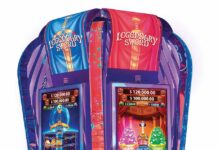by Eric Casey
In 1988, the Indian Gaming Regulatory Act provided this visionary definition of Class II gaming: “The term ‘‘Class II gaming’’ means… the game of chance commonly known as bingo (whether or not electronic, computer, or other technologic aids are used in connection therewith).”
The definition of Class II bingo was born around the traditional session bingo hall, which at the time played the game with paper bingo cards and ink daubers, when early and primitive technologic aids to bingo were just beginning to form. In 1988, only 15% of U.S. households had a computer of any sort; yet that IGRA definition of Class II Bingo has held up for 32 years of astounding technological evolution and tribal gaming development. Traditional session bingo has held up for 32 years since IGRA too.
Still played with paper bingo cards and ink daubers, the typical bingo hall now seamlessly integrates all manner of “electronic, computer, or other technologic aids” as enabled by IGRA. The bingo hall has survived, adapted, and for the most part, prospered, bridging generations of players and providing a social gaming experience like none other in more than one-hundred tribal bingo halls across Indian Country. Then in March of 2020, every single one of them shut down.
Here, in the sixth month of the COVID-19 pandemic, about 60% of these tribal bingo halls remain closed. Nothing is as it was. For a bingo hall to reopen, management must contend with capacity restrictions, lower headcounts in general, and the challenge of developing a prize payout that can sustain player interest while still generating profitability – all with an operational budget that’s been turned inside out.
The process of reopening tribal casinos and their myriad components, whether slots, table games, bingo, or F&B and hotel, is a process necessarily unique to each tribe. The good news for bingo is that those halls that have reopened are doing well and forging a road back to a new normalcy.
Safety First: Reopening a bingo hall begins with providing a safe environment and promoting employee and consumer confidence. Think of it: the primary bingo player demographic is 55+, and the game calls for players to sit in large groups for some hours as the session is played. To counteract player trepidation about COVID-19 exposure, the bingo hall cleaning and sanitization processes are paramount… and labor intensive.
Tribal bingo halls come in all shapes and sizes, from a hundred seats to over a thousand. Social distancing guidelines have temporarily reduced most hall seating capacities by 50% or more, but still every table and every chair, any drink station that’s open, all of the POS counters… everything has to be sanitized between sessions. And in addition to paper bingo cards, most bingo halls provide electronic bingo devices, either fixed-base computers or portable handsets, scores or even hundreds of which have to be disinfected after every use. This sanitization process requires staff training and unprecedented time and labor to manage.
Also critical is communicating the tribal focus on player safety to the players themselves. Messaging that explains exactly what is being done throughout the property and even bingo-caller reinforcement to the crowd on requirements that may include keeping social distance and wearing masks while playing bingo – the messaging connects the player to the sense that their health and safety is being consciously, proactively cared for. All this is being done, and done well, as bingo halls slowly reopen across Indian Country.
Uses of Technology: Sanitization requirements have led managers to evaluate the many ‘touch-points’ that bingo operations encompass. Managers are looking for opportunity to reduce those touch-points in areas such as cashiering and cash hand-pays for every game, as well as floor sales where paper bingo cards and event tickets are passed from hand to hand. This evaluation, in the last six months, has led to tremendous interest in solutions such as ‘mobile point of sale’ technology with which players can be ‘cashiered’ right at their seats to account-based payouts where player winnings can be credited to the bingo player account.
The player can top-up their account at anytime, make purchases right from their electronic bingo device, and cash out one-time at the end of the session. This also encourages more electronic bingo sales, where the higher levels of player-spend reside and the devices of which can be readily sanitized between sessions.
Sessions and Programs: At this six month mark of the pandemic, the reopened bingo halls are often working with reduced hours of operation and reduced seating capacity, as well as lower attendance at bingo sessions in general. While hopefully all of these factors are temporary, the challenge remains to run bingo profitably with the environment as it is today.
Bingo P&L begins with the relationship between average headcount, average per player spend, and the prize payout per session. If headcount goes down, either the player spend has to go up or the prize payout has to change to maintain margin. A key word here is ‘optimization.’
A handful of locations have been able to keep their old programs in place and bring in enough traffic to sustain profitability, but most have temporarily reduced their number of sessions per week to optimize their headcounts, and/or modified their bingo programs to optimize both spend and payouts.
There’s a notorious saying in the bingo industry that “bingo players don’t like change.” Somehow, this saying has held up for the 32 years since IGRA even while bingo has morphed completely across generations into new presentations and new technology. But for any managers concerned with making changes, now is the time.
Elevating the bingo buy-in, adding new electronic packages, adding new game-types and progressives to the session, are all happening options right now… there is very little if any player resistance to these changes. It seems we’re at the point in this pandemic where everyone realizes that everything has to change, and we should just expect it, make it happen, and move forward.
Another simple program-change tactic that is being temporarily deployed is pari-mutuel prize payouts. This takes a percentage of sales for each bingo game to the prize payout for that game and guarantees the hall a margin.
It can be done on some or all games in the session and the hold- percentage can be varied by game.
Other options include new product bundles (e.g. electronic bingo packages) at higher price points that add significant value to the player in the form of additional electronic cards. This approach can be tailored to all games in the session or to specific, high margin games, with the goal of increasing per-player spend.
Bingo is a continuous journey that traces its recognizable origins back to Italy in the 1500’s. The pandemic of 2020 is unprecedented. And the reopening of tribal bingo halls post-COVID-19 era will continue to be a long road ahead into uncharted territory, but it’s a positive story already with the ‘old normal’ being replaced with something quite new, driven by creativity and adaptation from tribal bingo management teams and their vendor resources. Bingo will survive, and 2020 will become yet another historical marker on the journey of Class II gaming.
Eric Casey is Sales Manager at Planet Bingo. He can be reached by calling (760) 808-6584 or email ecasey@planetbingo.com.
















































